| [1] 彭友霖,周丽丽,周艳红.镁合金作为生物医用植入材料的临床应用[J].中国组织工程研究与临床康复,2011,15(42):7923-7927.
[2] Witte F, Fischer J, Nellesen J, et al. In vitro and in vivo corrosion measurements of magnesium alloys. Biomaterials. 2006;27(7):1013-1018.
[3] Witte F, Kaese V, Haferkamp H, et al. In vivo corrosion of four magnesium alloys and the associated bone response. Biomaterials. 2005;26(17):3557-3563.
[4] 陈旭琼,尹庆水,张余,等.镁铝合金最大剂量的致敏试验[J].中国组织工程研究与临床康复,2010,14(16):2899-2900.
[5] Staiger MP, Pietak AM, Huadmai J, et al. Magnesium and its alloys as orthopedic biomaterials: a review. Biomaterials. 2006;27(9):1728-1734.
[6] 王飞,王钢,孟祥翔,等.新型镁合金皮内刺激与致敏实验研究[J].中国矫形外科杂志,2009,17(13):1013-1015.
[7] Zheng YF, Gu XN, Xi YL, et al. In vitro degradation and cytotoxicity of Mg/Ca composites produced by powder metallurgy. Acta Biomater. 2010;6(5):1783-1791.
[8] 葛淑萍,王贵学,沈阳,等.镁基合金应用于生物医用材料的研究进展[J].材料导报,2010,24(5):124-126.
[9] 李锴锴,王冰,严彪.镁合金作为生物医用材料的腐蚀与防护研究进展[J].腐蚀科学与防护技术,2012,24(3):181-184.
[10] 郑玉峰,顾雪楠,李楠,等.生物可降解镁合金的发展现状与展望[J].中国材料进展,2011,30(4):30-33.
[11] 陶冶,张永君.医用镁合金仿生钝化技术研究进展[J].电镀与涂饰,2012,31(3):39-42.
[12] 张广道. AZ31B生物可降解镁合金植入兔下颌骨生物学行为的实验研究[D].沈阳:中国医科大学,2009.
[13] 于国宁,张二林,徐丽萍.骨组织对镁合金植入材料的骨反应[C].北京:中国材料研究学会2006年会论文集,2006: 331-332.
[14] Witte F, Kaese V, Haferkamp H, et al. In vivo corrosion of four magnesium alloys and the associated bone response. Biomaterials. 2005;26(17):3557-3563.
[15] Peng Q, Huang Y, Zhou L, et al. Preparation and properties of high purity Mg-Y biomaterials. Biomaterials. 2010;31(3): 398-403.
[16] Gu X, Zheng Y, Cheng Y, et al. In vitro corrosion and biocompatibility of binary magnesium alloys. Biomaterials. 2009;30(4):484-498.
[17] Zhang EL, Yin DS, Xu LP, et al. Microstructure, mechanical and corrosion properties and biocompatibility of Mg–Zn–Mn alloys for biomedical application. Mater Sci Eng C. 2009;29(3): 987-993.
[18] Liu CL, Xin YC, TangGY.Influence of heat treatment on degradation behavior of bio-degradable die-cast AZ63 magnesium alloy in simulated body fluid.Mater Sci Eng A Struct Mater. 2006;456(1):350-357.
[19] Song Y, Zhang S, Li J, et al. Electrodeposition of Ca-P coatings on biodegradable Mg alloy: in vitro biomineralization behavior. Acta Biomater. 2010;6(5):1736-1742.
[20] Wang HX, Guan SK, Wang X, et al. In vitro degradation and mechanical integrity of Mg-Zn-Ca alloy coated with Ca-deficient hydroxyapatite by the pulse electrodeposition process. Acta Biomater. 2010;6(5):1743-1748.
[21] Song YW, Shan DY, Han EH. Electrodeposition of hydroxyapatite coating on AZ91D magnesium alloy for biomaterial application. Mater Lett. 2008;62(17-18): 3276-3279.
[22] Zhang EL , Xu LP, Yang K. Formation by ion plating of Ti-coating on pure Mg for biomedical applications. Scr Mater. 2005;53(5):523-527.
[23] 黄晶晶,任伊宾,张炳春,等.可降解镁植入材料表面涂层的制备及其性能[J].中国有色金属学报,2007,17(9):1466-1468.
[24] 徐丽萍,张二林,杨柯.医用镁合金表面磷化处理及生物腐蚀性能[J].电镀与精饰,2012,34(6):231-232.
[25] 高亚丽,熊党生.医用镁合金等离子喷涂羟基磷灰石涂层研究[J].材料热处理学报,2011,32(1):110-112.
[26] Wan YZ, Xiong GY, Luo HL, et al. Influence of zinc ion implantation on surface nanomechanical performance and corrosion resistance of biomedical magnesium–calcium alloys. Appl Surf Sci. 2008;254(17):5514-5516.
[27] Gu XN, Zheng W, Cheng Y, et al. A study on alkaline heat treated Mg-Ca alloy for the control of the biocorrosion rate. Acta Biomater. 2009;5(7):2790-2799.
[28] Tan LL, Wang Q, Geng F, et al. Preparation and characterization of Ca-P coating on AZ31 magnesium alloy. Trans Nonferrous Metals Society China. 2010;20(z2): 648-654.
[29] Yang JX, Cui FZ, Lee IS, et al. Plasma surface modification of magnesium alloy for biomedical application. Surf Coat Technol. 2010;205(S1):182-187.
[30] 王亚明,王福会,雷廷权,等.镁合金表面生物陶瓷涂层在模拟体液中的腐蚀性能[J].热处理技术与装备,2007,28(6):7-9.
[31] Shi P, Ng WF, Wong MH, et al. Improvement of corrosion resistance of pure magnesium in Hanks’ solution by microarc oxidation with sol–gel TiO2 sealing. J Alloys Compd. 2009; 469(1-2):286-292.
[32] Chen J, Zeng RC, Huang WJ, et al. Characterization and wear resistance of macro-arc oxidation coating on magnesium alloy AZ91 in simulated body fluids. Trans Nonferrous Metals Society China. 2008;18(S1):361-364.
[33] Lei T, Ouyang C, Tang W, et al. Enhanced corrosion protection of MgO coatings on magnesium alloy deposited by an anodic electrodeposition process. Corros Sci. 2010;52(10): 3504-3508.
[34] 李姝,董寅生,盛晓波,等.医用 AZ31 镁合金表面复合膜层的制备及其性能表征[J].表面技术,2010,39(1):41-44.
[35] Xu L, Pan F, Yu G, et al. In vitro and in vivo evaluation of the surface bioactivity of a calcium phosphate coated magnesium alloy. Biomaterials. 2009;30(8):1512-1523.
[36] 高亚丽,熊党生,王存山,等.医用镁合金激光熔覆羟基磷灰石涂层初探[J].特种铸造及有色合金,2009,29(4):304-306.
[37] 许鑫华,程静,张春怀,等.医用镁合金的生物腐蚀及高分子涂层处理[J].稀有金属材料与工程,2008,37(7):1225-1227.
[38] 颜廷亭,谭丽丽,熊党生,等.生物医用AZ31B 镁合金表面稀土转化膜的制备及其性能研究[J].稀有金属材料与工程,2009,38(5): 918-923.
[39] Witte F, Fischer J, Nellesen J, et al. In vivo corrosion and corrosion protection of magnesium alloy LAE442. Acta Biomater. 2010;6(5):1792-1799.
[40] Liu C L, Xin YC, Tian XB, et al. Corrosion resistance of titanium ion implanted AZ91 magnesium alloy. J Vac Sci Technol A. 2007;25(2):334-340.
[41] 国家质量监督检验检疫总局. GB/T 16886.15-2003/ISO 10993-15:2000 医疗器械生物学评价 第15部分:金属与合金降解产物的定性与定量[S].北京:中国标准出版社.2003.
[42] 邹鹑鸣.钛丝烧结制备医用多孔钛及其表面Si-HA生物活化[D].哈尔滨:哈尔滨工业大学.2007.
[43] Kim HM, Takadama H, Kokubo T, et al. Formation of a bioactive graded surface structure on Ti-15Mo-5Zr-3Al alloy by chemical treatment. Biomaterials. 2000;21(4):353-358. |
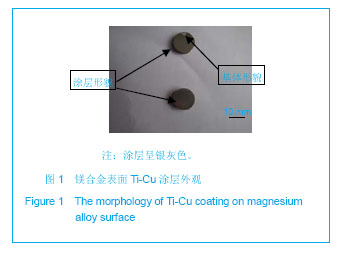

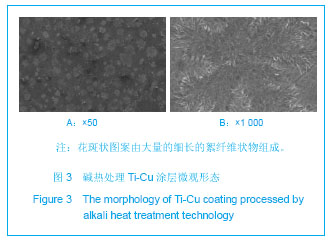
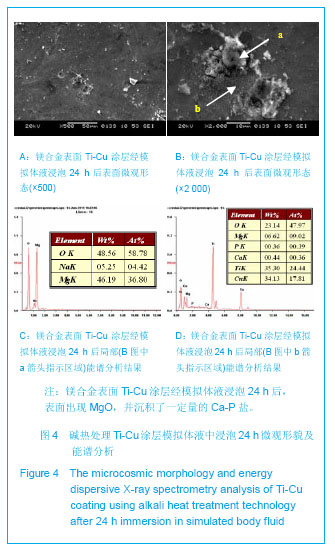
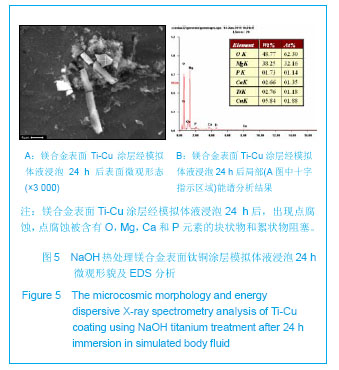
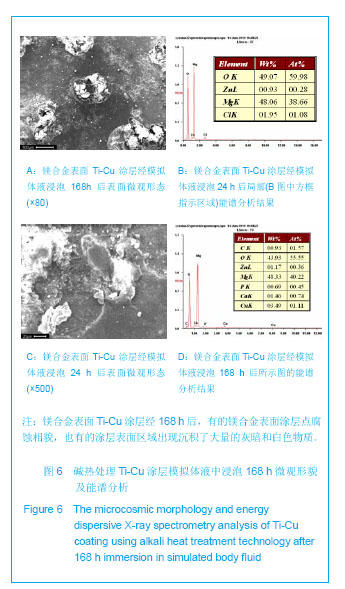
.jpg)
.jpg)